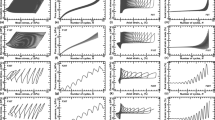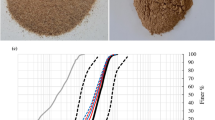Abstract
Nano silica sol (NSS) grouting is an effective method to improve water blocking capacity of rock fracture and fine sand. However, the mechanical and rheological properties of NSS grout remain poorly investigated. We study the properties by (1) measuring gelling time of NSS grout with a different accelerator dosage, (2) measuring shear strength of NSS with fall-cone test, (3) measuring the permeability coefficient of NSS, (4) measuring uniaxial compressive strength (UCS) of NSS mortar with different accelerator dosage and different curing conditions, and (5) conducting scanning electron microscopy (SEM) tests on NSS mortars at the sample age of 28 days. A new parameter R is introduced to represent the amount-of-substance concentration ratio of silicon dioxide (SiO2) and calcium chloride (CaCl2) in the mixture of NSS grout and the accelerator solution. It is proven that the gelling time of NSS grout increases exponentially with the increase of R. The equation of real-time viscosity and permeability length is derived. The strength development of NSS and the stress–strain relationship of NSS mortar is observed. The corresponding relationship between the micromorphology and macro-mechanical properties of NSS mortar is revealed. Furthermore, the non-monotonicity of experimental data is discussed and a possible reason is given.

The gelling time of NSS grout increases exponentially with the increase of accelerator dosage. The equation of fitted gelling time is derived through the gelling time test. The shear strength of NSS is measured through the fall-cone test. The permeability coefficient of the NSS is measured by the variable head permeability test. The stress-strain relationship of NSS mortar is revealed through the UCS test. The micro-morphology is observed through the SEM test. The weak bond of NSS explains why the stress is low and strain is large.
Highlights
-
The effect of NSS/accelerator volume and concentration is first unified.
-
The equation of real-time viscosity and real-time permeability length is first derived.
-
The micromorphology of NSS mortar at high magnification appears as irregular particles and gaps.








Similar content being viewed by others
References
Morris CA, Anderson ML, Stroud RM, Merzbacher CI, Rolison DR (1999) Silica sol as a nanoglue: flexible synthesis of composite aerogels. Science 284(5414):622–624
Henn RW, Soule NC (2010) Ultrafine cement in pressure grouting. American Society of Civil Engineers, Reston
Persoff PG, Finsterle S, Moridis GJ, Apps J, Pruess K (1995) Injectable barriers for waste isolation. Office of Scientific & Technical Information Technical Reports. Lawrence Berkeley Lab, California
Moridis G, Persoff P, Apps JA, Myer L, Pruess K, Yen P (1995) A field test of permeation grouting in heterogeneous soils using a new generation of barrier liquids. Office of Scientific & Technical Information Technical Reports. Lawrence Berkeley Lab, California
Bolisetti T, Reitsma S, Balachandar RJ (2009) Experimental investigations of colloidal silica grouting in porous media. J Geotech Geoenviron Eng 135(5):697–700
Gallagher PM, Conlee CT, Rollins KM (2007) Full-scale field testing of colloidal silica grouting for mitigation of liquefaction risk. J Geotech Geoenviron Eng 133(2):186–196
Meegoda JN, Tantemsapya N (2007) Microscopic modeling of colloidal silica stabilized granular contaminated soils. J Mater Civ Eng 19(1):91–98
Butrón C, Gustafson G, Fransson Å, Funehag J (2010) Drip sealing of tunnels in hard rock: a new concept for the design and evaluation of permeation grouting. Tunn Undergr Space Technol Inc Trench Technol Res 25(2):114–121
Funehag J, Fransson Å (2006) Sealing narrow fractures with a Newtonian fluid: model prediction for grouting verified by field study. Tunn Undergr Space Technol 21(5):492–498
Axelsson M (2006) Mechanical tests on a new non-cementitious grout, silica sol: a laboratory study of the material characteristics. Tunn Undergr Space Technol Inc Trench Technol Res 21(5):554–560
Funehag J, Gustafson G (2008) Design of grouting with silica sol in hard rock–New design criteria tested in the field, Part II. Tunn Undergr Space Technol Inc Trench Technol Res 23(1):9–17
Pan D, Zhang N, Xie Z, Feng X, Kong Y (2016) Laboratory testing of silica sol grout in coal measure mudstones. Materials 9(11):940
Manchester KR, North-Abbott MA, Zaluski MH, Trudnowski JM, Bickford JL (2001) Colloidal silica grout selection and characterization in support of the barrier deployment at Brookhaven National Laboratory. MSE Technology Applications, Montana
Butrón C, Axelsson M, Gustafson G (2009) Silica sol for rock grouting: Laboratory testing of strength, fracture behaviour and hydraulic conductivity. Tunn Undergr Space Technol 24(6):603–607
El Tani M, Stille HJ (2017) Grout spread and injection period of silica solution and cement mix in rock fractures. Rock Mech Rock Eng 50(9):2365–2380
Pedrotti M, Wong C, El Mountassir G, Lunn R (2017) An analytical model for the control of silica grout penetration in natural groundwater systems. Tunn Undergr Space Technol 70:105–113
Shen P, Hankins N, Jefferis SJG (2017) Selection of colloidal silica grouts with respect to gelling and erosion behaviour. Geosciences 7(1):6
Pan D, Zhang N, Zhang C, Qian D, Han C, Yang S (2018) Long-term mechanical behavior of nano silica sol grouting. Nanomaterials 8(1):46
Kong D, Corr DJ, Hou P, Yang Y, Shah SP (2015) Influence of colloidal silica sol on fresh properties of cement paste as compared to nano-silica powder with agglomerates in micron-scale. Cem Concr Compos 63:30–41
Holmboe M, Wold S, Petterson T (2011) Effects of the injection grout Silica sol on bentonite. Phys Chem Earth 36(17–18):1580–1589
Quercia G, Spiesz P, Hüsken G, Brouwers H (2014) SCC modification by use of amorphous nano-silica. Cem Concr Compos 45:69–81
Heck CA, dos Santos JHZ, Wolf CR (2015) Waterborne polyurethane: the effect of the addition or in situ formation of silica on mechanical properties and adhesion. Int J Adhes Adhes 58:13–20
Heping X (2017) Research framework and anticipated results of deep rock mechanics and mining theory. Adv Eng Sci 49(2):1–16
Funehag J (2012) Guide to Grouting with Silica Sol: For Sealing in Hard Rock. Stiftelsen Bergteknisk forskning, Stockholm
Meifeng C (2002) Rock Mechanics and Engineering. Science Press, Beijing
Funehag J, Gustafson G (2008) Design of grouting with silica sol in hard rock–New methods for calculation of penetration length, Part I. Tunn Undergr Space Technol 23(1):1–8
Acknowledgements
This work was supported by National Key Research and Development Program (Grant number 2016YFC0600803), Natural Science Foundation of China (Grant numbers 51879150 and 51809115).
Author information
Authors and Affiliations
Corresponding author
Ethics declarations
Conflict of interest
The authors declare that they have no conflict of interest.
Additional information
Publisher’s note: Springer Nature remains neutral with regard to jurisdictional claims in published maps and institutional affiliations.
Rights and permissions
About this article
Cite this article
Wang, P., Li, S., Li, Y. et al. Experimental research on rheological and mechanical properties of nano silica sol grout. J Sol-Gel Sci Technol 91, 178–188 (2019). https://doi.org/10.1007/s10971-019-04994-5
Received:
Accepted:
Published:
Issue Date:
DOI: https://doi.org/10.1007/s10971-019-04994-5




